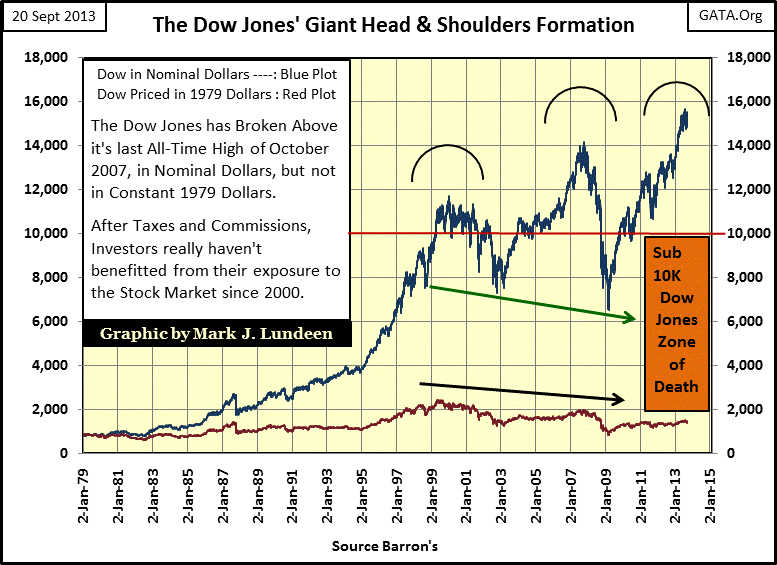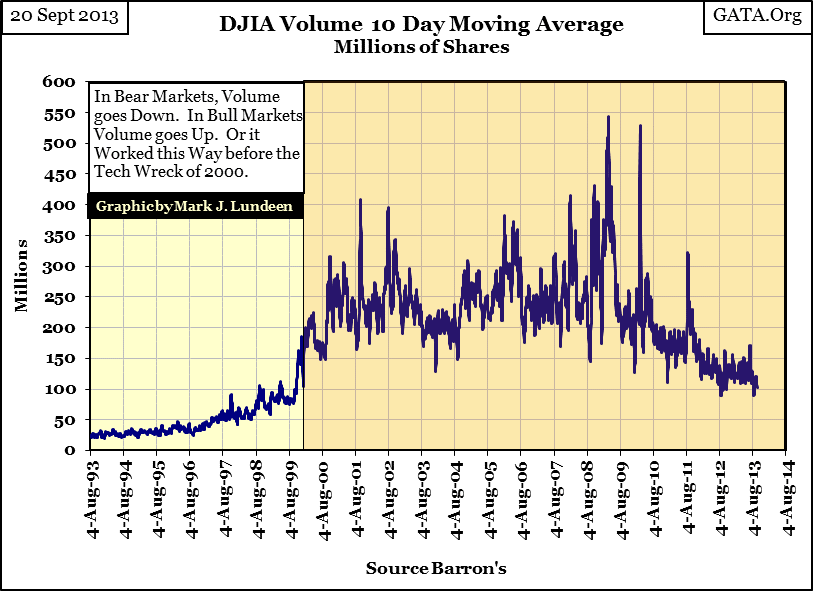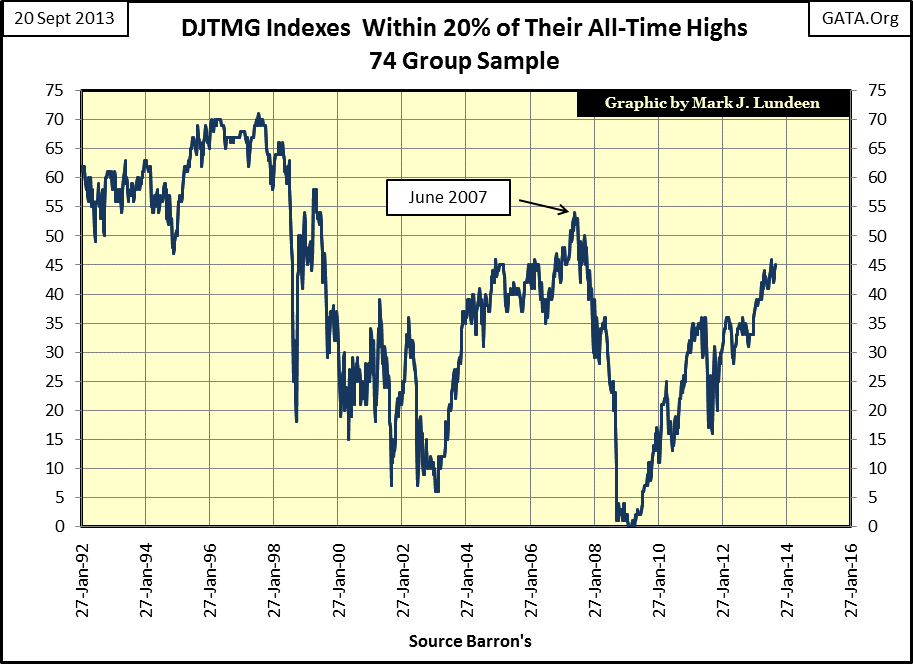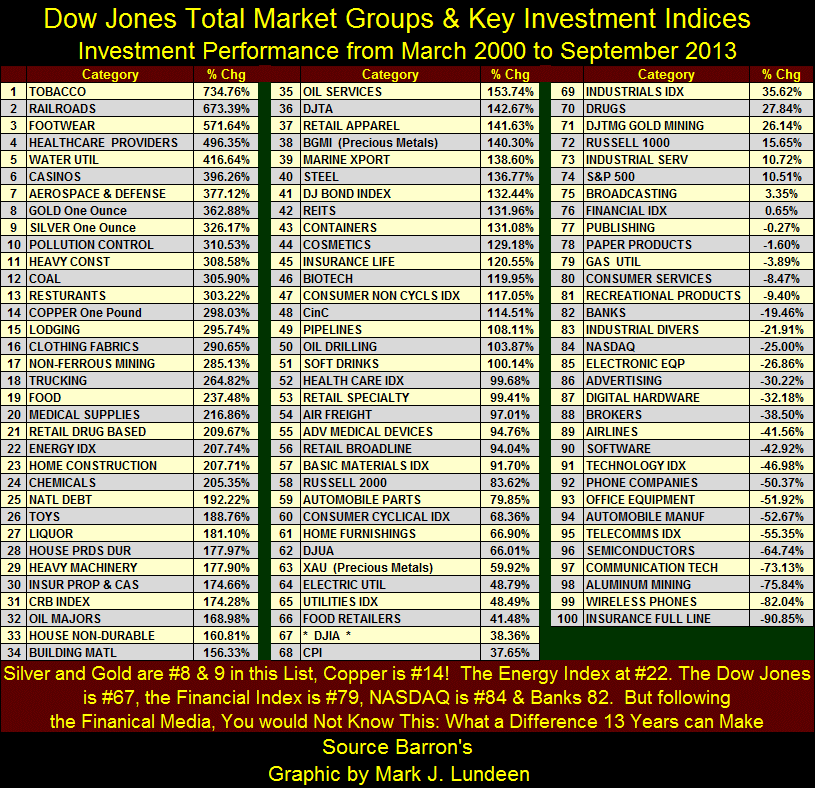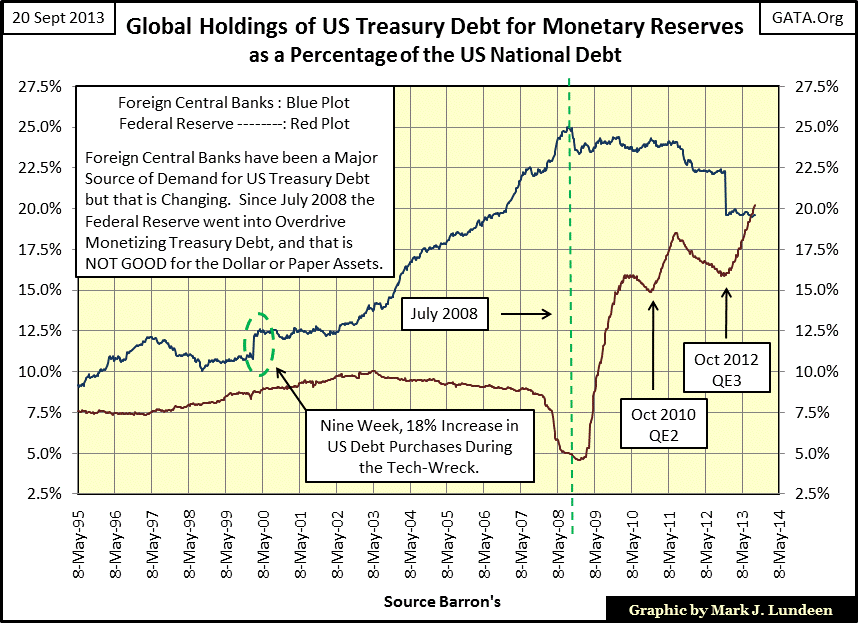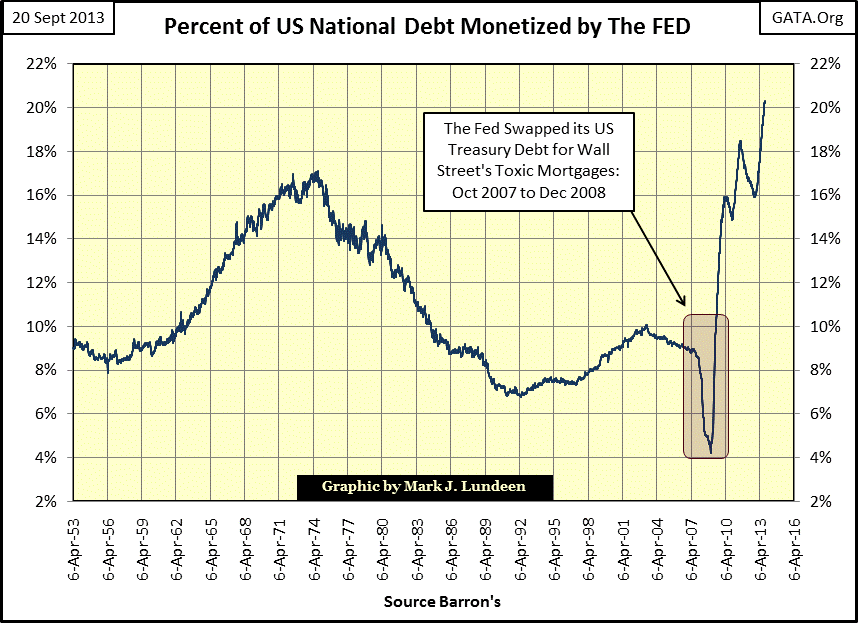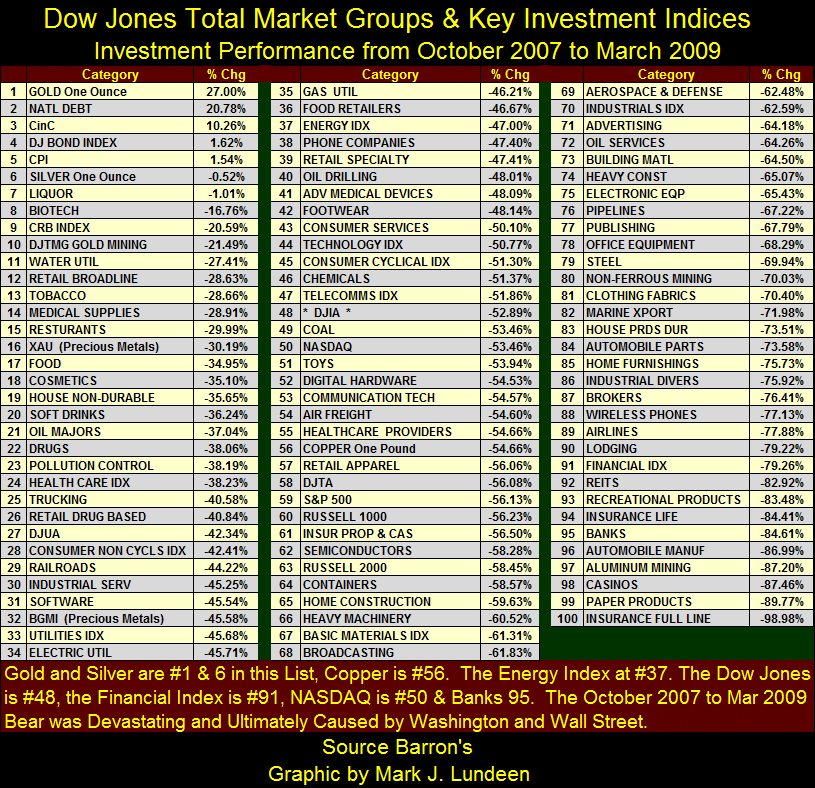Bull Market in Stocks? Are you Sure?
I haven’t shown the following chart since last winter when it appeared the Dow Jones was working on a Head & Shoulder top; hence the three half circles over the 2000, 2007 and our current 2013 advance. With the Dow Jones now approaching 16000, it’s clear the bearish H&S technical pattern failed. But that doesn’t mean the Dow Jones, and by proxy the broad stock market is in a new bull market promising substantial profits for investors in the months and years to come.
There are good reasons to expect the current rise in the Dow Jones will prove to be just another inflationary bubble market created by the Federal Reserve. Not the least is the horrible trading volume supporting the Dow Jones as it once again made a new all-time high this week. Since daily trading volume records have been kept, bull markets occur with rising trading volume. That was certainly the case until 2000 when Greenspan’s high-tech bubble went bust. It’s not hard figuring out why trading volume and market valuation should rise and fall together. When the public wants in on the buying and selling at the NYSE, it’s because they want in on the easy money being made in the stock market, so volume rises as the public enters the market with their cash. However, when there is more money to be lost than made in the stock market, the public leaves the market with as much dignity as their reduced financial situation allows. Stock valuation and trading volume declines when the public takes what is left of their money with them. This is why historically bear markets have seen a contraction in trading volume.
But in the aftermath of the high-tech bubble, these well established relationships reversed. Post 2000 in the chart below, it’s evident that declining market valuations occurred with rising trading volume, and rising market valuations happen on deeply declining trading volume. To make my point, the 10 Day moving average for the Dow Jones trading volume was 544 million shares in March 2009 as the Dow Jones fell to its second deepest bear market in history. The March 2009 bottom occurred on historic all-time high trading volume; that is very strange. This week, the Dow Jones made a new all-time high as its volume’s 10 M/A was only 105 million shares. It’s hard explaining how the Dow Jones could make a new all-time high this week on an 80% decline on trading volume since March 2009’s bottom. This is just not right.
It’s important understanding that since January 2000, trading volume and market valuation patterns of over one hundred years have been turned on their heads. And seeing how current trading volume for the 30 Dow Jones stocks have declined to levels not seen since 1999, it’s safe assuming the public has yet returned to the stock market as the Dow Jones approaches an amazing 16,000. After the high-tech and mortgage bubbles, I expect most working people who were interested in buying low to sell high were either wiped out or have seen the error of their ways and aren’t coming back.
Today, few people really care if the Dow Jones is moving into record territory. Past excitement on making new historic highs in the market that was so ubiquitous years ago is missing today even in the financial media. This is a market with minimum participation by the public; that leaves the bulk of the buying and selling in the stock market to professional money managers who use other people’s money to finance their trades. But the big players in the stock market today are the big Wall Street banks and hedge funds financed by unlimited-cheap credit from the Federal Reserve, who use high-frequency trading programs to manage stock valuations at acceptable levels, maximizing their profits in the process. If it wasn’t for these institutions high-frequency trading, I suspect that daily trading volume in today’s stock market would mostly disappear.
If you think about it you’ll realize how weird this “bull market” in stocks is. It’s occurring during a multi-year recession (2008-2013), noted for its high unemployment. Our recession shows no signs of ending, and since the summer of 2012 long term bond yields have begun to rise for the damn good reasons that the world is being overwhelmed by its consumptive debts that can never be repaid. The Dow Jones should not be making new all-time highs under such conditions – but it is. This is another sign that fundamentally something is terribly wrong with the stock market.
The following is an interesting chart; the number of stock groups in the Dow Jones Total Market Group (DJTMG) within 20% of making a new all-time high. I tend to discount the high number of indexes at such high levels during the 1990s as my data only begins in 1992, and so this period of data lacks history. But the high of June 2007 came after a major 38% decline in the Dow Jones in 2002, and so is good data. Seeing 54 groups in the DJTMG within 20% of a new all-time high just five years after the 2002 tech-wreck bottom, as the Dow Jones and S&P moved from one new all-time high to another, proves that money was coming into the stock market. But the timing of this “bull market” also corresponds with the sub-prime mortgage bubble. When the mortgage bubble went bust in 2008, it took the stock market down with it, proving to my satisfaction that the two were connected by a common thread – “liquidity” flowing from the Federal Reserve.
Now in 2013, we see once again an increasing number of groups in the DJTMG within 20% of a new all-time high. No doubt this is a strong market, but is it a good market to risk one’s money in? The Dow Jones earnings today are at record highs, but the same was true during the 2007 peak in this chart, and those record earnings from 2007 evaporated quickly and actually became negative as the mortgage and stock market bubbles deflated in 2008-09.
I gave up predicting dates when something is going to happen, like a market crash or a major breakout for gold and silver. I’m only reminding my readers that at the heart of the high-tech and mortgage bubbles, sat the Federal Reserve inflating the money supply, which the Fed then “injected” into the banking system. But both bubbles went bust and there was nothing the Federal Reserve could do to stop massive price declines in either high-tech stocks or real estate values once their declines began. Now for the third time in three decades the Federal Reserve is injecting massive amounts of “liquidity” into the banking system, and once again the stock market is rising to new all-time highs on record earnings. There is a pattern here, and the two previous market cycles in the pattern include a massive bear market correction.
If you’re in the market, don’t fall in love with your stocks as one day this bubble is going to go bust as all bubbles do, and ultimately bring more grief than capital gains to investors. The stock bulls could have seen a sharp decline on Wednesday of this week had Doctor Bernanke announced a tapering on his QE program. The stock market just this summer began upchucking when Doctor Bernanke first muttered the dirty T-Word: taper. What happens to stock valuations if the Fed actually does taper their current QE? What happens if they don’t taper sometime in the next year? Regrettably, after nineteen years of Alan Greenspan running the Federal Reserve (1987 – 2006), most market moving news today has something to do with the government’s plans, or change of plans for the economy. That too is a sign of a bubble market.
To keep things in perspective, we should understand that the Dow Jones is only 38% above its high of 2000. But look at what it had to go through in the past thirteen years to get here; a 38% bear bottom in 2002, and a 53% (the second deepest bear market since 1885) in March 2009. But all this is in nominal dollars. The Red Plot in the Dow Jones chart above shows the Dow Jones in constant 1979 dollars. In inflation adjusted terms (deflated with CinC) the Dow Jones today has lost 35% of its purchasing power since its March 2000 top. For retail investors and money managers who have stayed with the stock market since 2000, I wonder how many really are better off for the experience. They could be, if like Warren Buffet, investors were smart enough to be in the right stock group like railroads, or decided to invest in gold and silver bullion in 2000.
Here’s a performance table for the Dow Jones Total Market Group (DJTMG) and other indexes of interest from March 2000 to September 2013. CPI (#68) is the government’s inflation index, but I prefer measuring inflation by the growth in the number of paper dollars and base-metal coins in circulation (CinC #48). As far as I’m concerned, the only groups that have provided investors with a real after inflation returns are those that have increased more than CinC; or 114% in the past thirteen years. There are groups in the table whose gains were below the increases in CinC, yet returned a nominal dollar profit (#49-76). However those dollar gains have not improved one’s financial situation since 2000, though you did have to pay the capital gains taxes on the “profits.”
The financial media likes to focus on the Dow Jones (#67) and the S&P 500 (#74) in their coverage of the markets, which is understandable. But with these blue-chip indexes’ gains of the last thirteen years, the past decade was no bull market for blue-chip stocks. What a difference thirteen years blue-chip stocks had from August 1982 to August 1995. The Dow Jones was up 390% and the S&P up 345% with CinC increasing only 76%. Unlike now, people were excited by the stock market during the 1982-2000 bull market because retail investors really were making excellent inflation adjusted profits during the Greenspan bubble market. Though being an inflationary bubble it could never last. To see how much things have changed since 2000, in the table above we find most of the hot stocks for the high-tech bubble below the NASDAQ Composite index (#84). Apple is still a much loved stock, but with its competitors in the smart phone business down some 82% (#99). I wonder how long AAPL can fight the downtrend other tech stocks have succumbed to since 2000.
And being near the top of the above list doesn’t guarantee the stock group will stay there. Hot groups didn’t do well after the October 2007 top in the mortgage-bubble market. The thing to remember about the October 2007 to March 2009 bear market was that it was the result of a banking-liquidly crisis that overwhelmed the global economy. The illiquid banking system of 2007-09 created havoc for companies whose business had little to do with the world of finance, and the same will be true in the next banking crisis. The Bank of International Settlement (BIS) called the last banking crisis before the October 2007 top, and now six years later they are once again pointing out uncomfortable truths in contemporary finance to anyone willing to listen.
BIS veteran says global credit excess worse than pre-Lehman
“Extreme forms of credit excess across the world have reached or surpassed levels seen shortly before the Lehman crisis five years ago, the Bank for International Settlements has warned.”
This news is hardly surprising as absolutely nothing has been corrected in the world of high finance since March 2009. When Mr Bear goes to work he has only one purpose in his labors, and that is to take out the trash Wall Street has created, and sold to the public in the previous bull market. Marking-to-market and the liquidation of unviable assets are the orders of the day during bear markets, and the liquidation of unviable assets held by banks has been one thing the “policy makers” have refused to allow since the Japanese real estate and stock market bubbles went bust in 1989. Wall Street lost billions in Japan twenty-four years ago, and now Wall Street is on the verge of losing tens or hundreds of trillions. The Greenspan Fed in the early 1990s bailed the big banks out with low interest rates and “injections of liquidity”, establishing a pattern of monetary misconduct that continues to this day. However, the fraudulent OTC derivative market, with its $600 trillion notional dollar valuation could easily overwhelm any effort by governments and their central banks in another credit crisis. It almost did in the last credit crisis.
But in the last crisis, the “policy makers” were successful in reversing the declines Mr Bear intended to inflict on market valuations, but I don’t believe they will be successful in the next credit crisis. Below is a chart showing the percentages of the US National Debt monetized by foreign central banks (Blue Plot) and the Federal Reserve (Red Plot). During the high-tech bubble (1995-2000), the global central banking system never monetized more than 20% of the US Treasury market. But during the housing bubble (2002-2008) which inflated the global real estate market, especially the European and American markets, foreign CBs monetized an additional 13% of the US Treasury market as the Federal Reserve’s position in the Treasury market stayed below 10%.
But all that changed in 2009, when during the mortgage crisis the Federal Reserve began monetizing Congress’s unpaid bills with abandon. The Federal Reserve’s huge increase in US T-debt holdings is obviously part of the economic rescue plan Doctor Bernanke prescribed for the economy. However since 2009 his fellow central bankers have not been interested in going along with the plan, and that is a problem.
To see how big a problem, let’s look at the percentage of the US National Debt the Federal Reserve has monetized since 1953. Over the long term, the Federal Reserve never reduces its holdings of US Treasury debt. So the best way to understand the following plot is know that when it decreases, the Federal Reserve is monetizing the US Treasury Market at a slower rate than the Federal government is going into debt. And when the plot increases, the Federal Reserve is monetizing the national debt at a faster rate than the Federal Government is spending other people’s money.
We see the obvious reason above for the rising inflation of the 1960s and the double-digit inflation rates of the 1970s; the Federal Reserve increased its holdings of the US national debt from 8% to 17% from 1956 to 1974. The international outcry at the termination of the Bretton Woods gold standard in 1971, and the double digit annual price increases in energy and commodity prices finally forced the Federal Reserve to begin to act responsibly. In 1974 the Federal Reserve’s presence in the US Treasury market began to shrink. The big decline seen in the red box was due to the Federal Reserve swapping its T-debt for toxic mortgage assets with the big Wall Street banks, and the Federal Reserve has been monetizing single home mortgages ever since. In fact just under half of the debt being monetized by the Federal Reserve in the current QE program is mortgages. If not, the Federal Reserve would have had to monetize considerably more than its current 20% of the US Treasury market to keep the market “stabilized.” Twenty percent of the US Treasury market has been monetized by the Federal Reserve and injected into the banking system. I don’t know about you, but that is shocking to me.
I could be wrong, but the above two charts strongly suggests that the world we now live in is greatly different than it was during the 2007-09 mortgage crisis. If asked to bail out Wall Street once again, can the Federal Reserve and US Treasury succeed if that means that the Federal Reserve has to monetize over 30% of the US Treasury market? If they do, there is a good chance that the US dollar would lose its “reserve currency” status, producing a panic in the US dollar and bond markets, causing bond yields to explode to double digits. Such a spike in bond yields would ignite the multi hundred-trillion dollar powder keg in the OTC interest rate derivative market. To have interest rate derivatives come into the money by the hundreds of trillion would devastate the American banking system. There is no way the US government can bail out Wall Street, or itself in such a scenario.
Lest we forget how bad things were in March 2009, the table below shows how brutal the stock market decline was in the last credit crisis. And this decline was greatly mitigated by the US Treasury and Federal Reserve’s market interventions, as promised by the US Secretary of the Treasury (Hank Paulson) and Federal Reserve Chairman (Doctor Bernanke) on live TV during emergency-Congressional testimony in October 2008. Had they failed, and Mr Bear been successful in removing the accumulation of decades of bogus assets Wall Street passed off to their clients and held on the public’s balance sheets as AAA assets, the losses seen below would have been much, much worse. Remember, these losses occurred on exploding trading volume that magically appeared from nowhere. But the buy orders for the stock market had to be funded by the Federal Reserve, and executed by the big Wall Street trading houses. Treasury Secretary Paulson and Fed Chairman Bernanke promised as much on live TV for fear of the NYSE becoming a no-bid market for many of its listed shares.
I’m not a cheerleader for Mr Bear. He’s coming for me too. I’m just acknowledging that he performs a necessary function in the market. By taking out financial trash during bear markets and causing great pain to all in the process, the fear of Mr Bear inspires integrity with politicians, keeps Wall Street honest and money managers skeptical of what investment banker’s sales staff are trying to pass on to the market as investments. But that all changed in October 1987 when Alan Greenspan first bailed out the market during a crash by flooding the market with “liquidity.” Since then no matter how dumb some investment decisions were by politically-connected financial institutions in the past three decades, they still made money for the rich and powerful, if not the public. People of influence, who should know better, really do believe that college professors like Doctor Bernanke, if given control over the money supply and interest rates, can prevent bear markets in asset prices. The financial media, financial analyses, politicians and their government regulators stopped asking hard questions in the early 1990s, and began going along to get along with the powers that be on Wall Street.
What is really disturbing is the success academics, politicians and their central bankers have had in convincing the media and the general public that they have a moral duty to prevent bear markets via inflationary-market interventions. Before the Greenspan Fed, managing markets in this manner would have sounded ridiculous. But now at the twilight of the Bernanke Fed, all eyes are on the Fed Chairman to see how he is going to keep asset prices going up, and bond yields down. And as always, it will be by monetizing debt and “injecting” the resulting “liquidity” into the banking system. Expect the next financial crisis to stress test the ultimate viability of this monetary quackery and that Mr Bear will finally succeed in discount both the geniuses managing the central banking system, and the asset valuations they have supported with decades of monetary inflation. The middleclass in the United States really was much better off when the Dow Jones was at 250 in 1952 than it currently is at 15,500 in 2013. When the big furry fellow is finished with us it will be a very different world from the one we now live in.






